#cloudwatch aws
Explore tagged Tumblr posts
Text
Compare CloudTrail Vs CloudWatch Services in AWS
Full Video Link https://youtube.com/shorts/izMnQPCZeQk Check out CodeOneDigest's latest #video tutorial on #AWS CloudTrail vs CloudWatch! Learn about AWS CloudTrail & CloudWatch and stay ahead of the technology curve. #CodeOneDigest #YouTube #cloud
CloudTrail enables auditing, security monitoring, and operational troubleshooting by tracking user activity and API usage. CloudTrail logs, monitors, and retains account activity related to user actions across AWS infrastructure, giving you control over storage, analysis, and remediation actions. CloudTrail is active in your AWS account when you create it and doesn’t require any manual setup.…
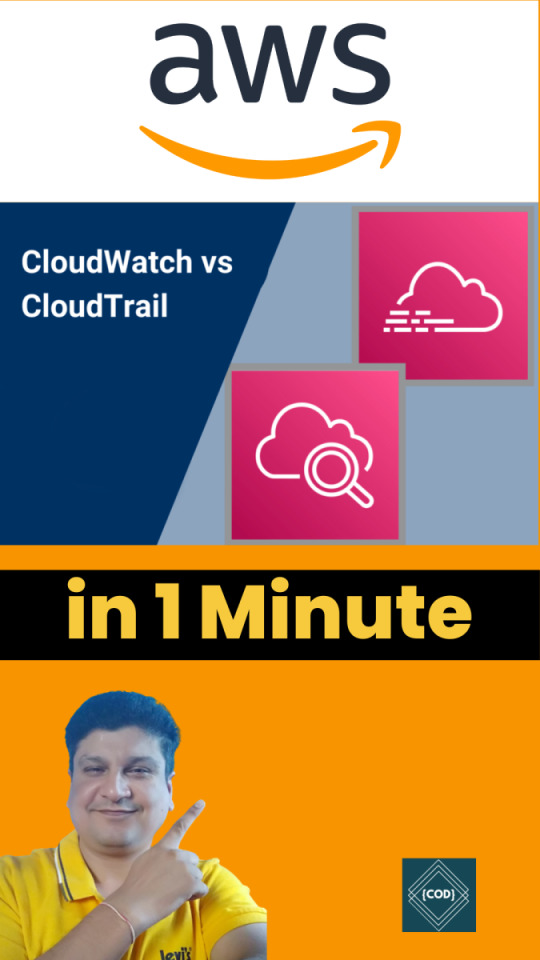
View On WordPress
#amazon cloudtrail vs cloudwatch#amazon web services#aws#aws cloud#aws cloudtrail tutorial#aws cloudtrail vs cloudwatch#aws cloudwatch vs cloudtrail#cloudtrail vs cloudwatch#cloudtrail vs cloudwatch vs config#cloudwatch and cloudtrail#cloudwatch and cloudtrail in aws#cloudwatch aws#cloudwatch service#cloudwatch vs cloudtrail#cloudwatch vs cloudtrail vs config#cloudwatch vs cloudtrail vs x-ray#difference between cloudwatch and cloudtrail#what is amazon web services
0 notes
Video
youtube
Amazon Aurora | High-Performance Managed Relational Database
Amazon Aurora
Amazon Aurora is a fully managed relational database engine compatible with both MySQL and PostgreSQL. It’s engineered for high performance, offering up to five times the throughput of standard MySQL and twice that of PostgreSQL. Aurora is ideal for high-demand applications requiring superior speed, availability, and scalability.
- Key Features:
- Automatic, continuous backups and point-in-time recovery.
- Multi-AZ deployment with automatic failover.
- Storage that automatically grows as needed up to 128 TB.
- Global database support for cross-region replication.
- Use Cases:
- High-traffic web and mobile applications.
- Enterprise applications requiring high availability and fault tolerance.
- Real-time analytics and e-commerce platforms.
Key Benefits of Choosing the Right Amazon RDS Database:
1. Optimized Performance: Select an engine that matches your performance needs, ensuring efficient data processing and application responsiveness.
2. Scalability: Choose a database that scales seamlessly with your growing data and traffic demands, avoiding performance bottlenecks.
3. Cost Efficiency: Find a solution that fits your budget while providing the necessary features and performance.
4. Enhanced Features: Leverage advanced capabilities specific to each engine to meet your application's unique requirements.
5. Simplified Management: Benefit from managed services that reduce administrative tasks and streamline database operations.
Conclusion:
Choosing the right Amazon RDS database engine is critical for achieving the best performance, scalability, and functionality for your application. Each engine offers unique features and advantages tailored to specific use cases, whether you need the speed of Aurora, the extensibility of PostgreSQL, the enterprise features of SQL Server, or the robustness of Oracle. Understanding these options helps ensure that your database infrastructure meets your application’s needs, both now and in the future.
#youtube#Amazon RDS RDS Monitoring AWS Performance Insights Optimize RDS Amazon CloudWatch Enhanced Monitoring AWS AWS DevOps Tutorial AWS Hands-On C
0 notes
Video
youtube
Terraform on AWS - CloudWatch + ALB + Autoscaling with Launch Templates|...
#youtube#🚀 Master Terraform on AWS: CloudWatch Alarms ALB Autoscaling & Synthetics | Infrastructure as Code Tutorial In this hands-on tutorial learn
0 notes
Text
Is AWS Elasticsearch Developer’s True Hero?

Elasticsearch is a free open source search engine, which is used for log analytics, full-text search, application monitoring and more. It makes easy to deploy, operate and scale Elasticsearch clusters in the AWS Cloud. We can get direct access to the Elasticsearch APIs. It provides Scalability, Availability and Security for the workload process run.
Elasticsearch architecture
The AWS Elasticsearch Service Architecture is very dynamically to allow create instances, remove instances, change instance sizes, change storage configuration and customize to make other changes. This Elasticsearch allows to search and analyse the data log. It consists of three components.
Logstash – is used to collect and transferred to the Elasticsearch.
Elasticsearch –facilitates search and analyze with the logs stored in it. It acts as a database.
Kibana –Kibana enables the data visualization on the dashboard that uses ELK stack. This tool provides a quick insight of the documents using visualization Kibana’s dashboard contains interactive diagrams, geospatial data, and graphs to visualize complex queries that let you search, view, or interact with the stored data. Kibana helps you to perform advanced data analysis and visualize your data in a variety of tables, charts, and maps.

Get started with an Elastic Cluster with AWS
First, create an AWS account and follow the following steps to claim your domain.
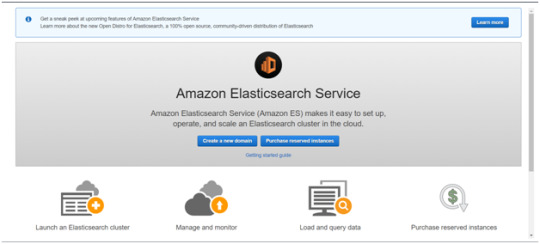
Tap on to “Create a new domain”
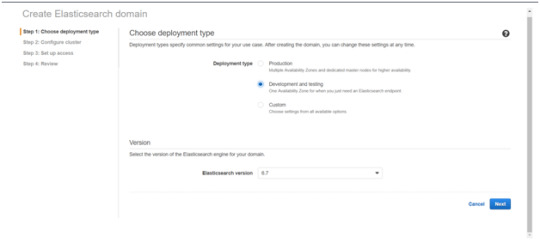
Select on the appropriated Deployment type and select the Elasticsearch version. Click Next.
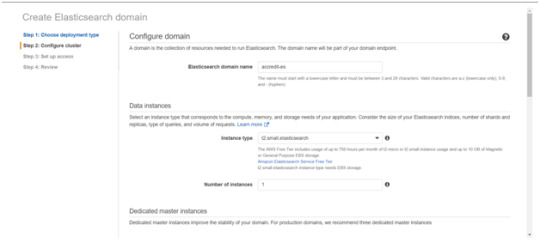
Enter a domain name and choose the Instance type in the prompt page and Click Next.
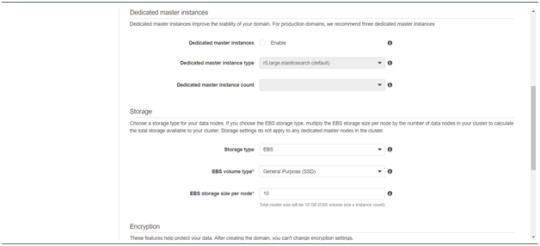
Follow to enter the “Dedicated master instances”
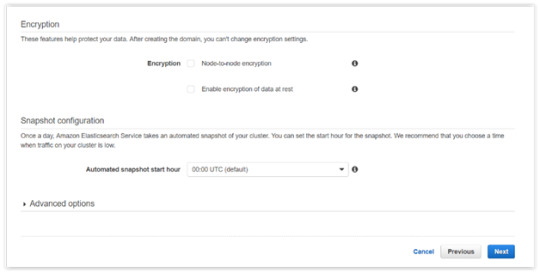
Click Next.
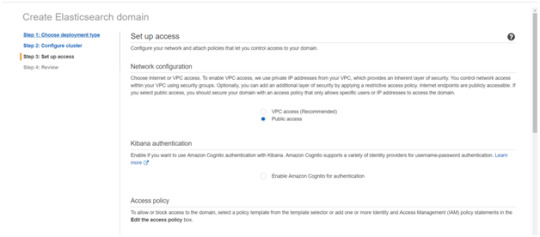
After the Cluster Configuration, you will be taken to the Set up access part. In the Setup access part, enable the specific set of users who can access your ElasticSearch cluster. There are two options — VPC access and Public access. Once you select one of the options and confirm your entries your new cluster is created.
Things to consider
1. Expandable
Amazon Elasticsearch Service provides to monitor your cluster through Amazon CloudWatch metrics.
We can change the cluster in various size from top or bottom within single clicks in the AWS management console or via a single API call.
There is a customizable setting available based on the range of instance types and storage options including SSD-powered EBS volumes.
2.Integrations
Many integrations available in the AWS Elasticsearch such as Kibana for data visualization, Amazon CloudTrail is used to audit API calls configure in AWS ES domains and integrate with Amazon Amazon S3, Amazon Kinesis, and Amazon DynamoDB for loading streaming data into Amazon ES.
3.Guarantee
It guarantees to provide a secure environment and easy integration with Amazon VPC and VPC security groups. There is an availability to access the Identity and Access Management (IAM) control. It provides authentication for Kibana and Data encryption with node-to-node encryption.
4.Availability
Amazon ES supports the different zones in two geographical locations and various node allocations with a large number of zones in the same region itself. It manages the cluster and notifies the damaged nodes automatically.
Conclusion
This article has covered what AWS Elastic Search means, its benefits, what happens between and how you can use it.
#AWS#Elasticsearch#LogAnalytics#SearchEngine#CloudComputing#DataVisualization#Kibana#Scalability#Security#CloudWatch#AWSIntegration#DataEncryption#VPC#ElasticCluster#API#CloudInfrastructure#TechSolutions#BigData#AWSElasticsearch#ElasticSearchService#DataAnalysis#CloudServices
0 notes
Text
ColdFusion and AWS CloudWatch: Monitoring and Logging Best Practices
#ColdFusion and AWS CloudWatch: Monitoring and Logging Best Practices#ColdFusion and AWS CloudWatch Monitoring#ColdFusion and AWS CloudWatch Logging Best Practices#ColdFusion and AWS CloudWatch#ColdFusion AWS CloudWatch#ColdFusion#AWS CloudWatch#ColdFusion Monitoring and Logging Best Practices#AWS CloudWatch Monitoring and Logging Best Practices
0 notes
Text
Save Big with Amazon CloudWatch: Affordable Log Storage
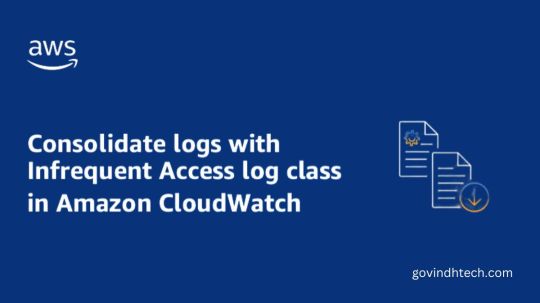
Amazon CloudWatch log class for infrequent access logs
Today, Amazon CloudWatch Logs unveiled the Infrequent Access log class, a new log class. With this new log class, customers can more affordably consolidate all of their logs in one location by providing a customized set of capabilities for infrequently visited logs at a lower cost.
The volume of logs created grows together with the scale and growth of customers’ applications. Many consumers are compelled to make difficult compromises in order to reduce the rise in logging expenses. Some customers, for instance, restrict the amount of logs their applications generate, which may impair the application’s visibility, or select a different solution for certain log categories, which increases the complexity and inefficiencies associated with managing various logging solutions.
Customers might, for example, provide CloudWatch Logs the logs required for real-time analytics and alerts and send a less expensive, less feature-rich solution the more detailed logs required for debugging and troubleshooting. Ultimately, these workarounds may affect the application’s observability as users are need to switch between several solutions in order to view their logs.
With the help of the Infrequent Access log class, you can use CloudWatch to create a comprehensive observability solution by centralizing all of your logs in one location for economical consumption, querying, and storing. The cost per gigabyte of ingestion for Infrequent Access is half that of Standard log class. For clients that don’t require sophisticated features like Live Tail, metric extraction, warning, or data protection functions that the Standard log class offers it offers a customized set of capabilities. You may still take advantage of fully managed ingestion, storage, and deep diving using CloudWatch Logs Insights with Infrequent Access.
How often to use the new log class for Infrequent Access
When you have a fresh workload that doesn’t require the advanced functionality offered by the Standard log class, use the Infrequent Access log class. It’s crucial to keep in mind that once a log group is created with a certain log class, it cannot be changed afterwards.
Because debug logs and web server logs are typically verbose and don’t require much of the more advanced features offered by the Standard log class, they are a good fit for the Infrequent Access log class.
An Internet of Things (IoT) fleet sending detailed logs that are only accessible for post-event forensic analysis is another excellent workload for the Infrequent Access log class. Additionally, because the Infrequent Access log type will be queried seldom, it is a desirable option for workloads where logs must be kept for compliance.
Getting started
Create a new log group in the CloudWatch Logs console and choose the new Infrequent Access log class to begin utilizing the new log class. The AWS Management Console, AWS Command Line Interface (AWS CLI), AWS CloudFormation, AWS Cloud Development Kit (AWS CDK), and AWS SDKs are the only ways to establish log groups using the new Infrequent Access log type.
You can use the newly generated log group in your workloads as soon as it’s created. You will set up a web application to submit debug logs to this log group for the purposes of this demonstration. You can return to the log group and view a fresh log stream after the web application has run for some time.
CloudWatch Logs Insights will be displayed when you choose a log stream.
You may make queries, search those logs for pertinent information, and rapidly examine all the logs in one location by using the same comfortable CloudWatch Logs Insights experience you receive with Standard Class.
Accessible right now
With the exception of the China and GovCloud regions, all AWS regions now offer the new Infrequent Access log class. You can get started with it and benefit from a fully managed, more economical method of gathering, storing, and analyzing your logs.
Read more Govindhtech.com
0 notes
Text

[ Moon 2 ] [ Newlight ] [ Part 1/1 ] ⊲ [ First ] | [ Previous ] | [ Next ] ⊳
Events: [ Freckle is grossed out by something ??? did.] [ ??? remembers something nice that Freckle did.] [ ??? was given wild garlic as treatment for claw-wound. They will heal sooner. ] [ ??? Is thinking about how awful kittypet food must taste ] [ Freckle is cloudwatching ] [ Try as she might, Freckle can't quite remember the exact shape of the ragwort leaves, and she isn't going to harvest from plants she hasn't confidently identified. Better safe than sorry, as they say. ]
#clangen#clangen comic#clangen challenge#clangen art#warrior oc#warrior oc art#astray-clangen#astray clangen#astray#astray comic page#moon 2#comic page#tw blood#tw injury#added image description if the text isn't clear enough! :)#sorry quiet week ive been running my friends dnd game waho!#also to make it clear#??? doesn't realise he died heh thats why hes asking
142 notes
·
View notes
Text
Day 14: Telling
The hunting party as a group stopped in their tracks not half a bell after they’d crossed the Gates of Judgment. The game here was less dangerous thanks to the increased military presence, and if somebody was badly hurt or lost in a snowstorm then Camp Dragonhead and Whitebrim were both close enough that aid could be sought and a rescue party summoned. Matthieu had planned to insist on this when his parish’s shooting club had invited him along, but to his relief he needn’t have concerned himself, as this was part of their usual route.
The club was a small one, the product of a few citizens in the parish coming into money thanks to Ishgard’s increased trade volume and deciding to put that coin to use acquiring some of Skysteel’s newest products. None of them were able to afford the aetherotransformer unit that turned the average rifle into a multi-faceted man-portable weapon of mass destruction, but having access to rifle and shot still made them feel like they were part of the new Coerthas and afforded them the chance to go out on hunts without years of training in spear or bow.
They’d insisted on Matthieu coming along at least once, and while he was generally well-liked by most of his constituents, he had to admit that he was most popular with the kind of people who got along with his aunt: older ladies who enjoyed their tea and gossip, found his willingness to help around the store to be charming, and lightly teased him about his relationship with Edda. That was enough of the parish to have gotten him elected, but he had to admit that getting others to like him more would help in the next election. In this case, that meant agreeing to attend one of the Crozier 4th’s Official Club of Jolly Fellows once-a-moon hunts.
The title was not of his choosing.
And so he’d agreed, gotten some assistance from his fellows in the Commons in selecting an easy-to-use carbine and how to load, point, and fire it without embarrassing himself, allowing for the knowledge that this was his first time out, and met up with a dozen of the Fellows at the Gates. The plan had been to traipse about the snows between the Gates and Whitebrim, take a few cloudkin or a wild karakul if the opportunity presented itself, then head back to help themselves to some beet stew and sort out who was the best and worst shot while their catches were prepared.
It was a cloudy morning, and while the cloudwatchers had suggested a mild chance of snow, visibility was still clear. The group had a clear view of the Nail interrupting the highlands in one large series of jagged peaks, and of what had stopped them: a single dragon, perched on one of the larger outcroppings, observing the comings and goings of the wildlife on the ground below.
“Fury, would you look at that.” Alort, the parish cobbler, made a quick sign of prayer to Halone, his tone of voice breathless. It wasn’t clear to Matthieu if he spoke in awe or fear.
“Never thought I’d see one of those without taking to my heels,” said Gaspardieux, the carpenter. “Still feels like I ought to.”
“That makes sense.” Matthieu kept his composure while he replied, simply raising a hand to the dragon in greeting. Events surrounding his election had given him more benign exposure to the Dravanian Horde than the average commoner, and he kept abreast of efforts to repatriate those who had turned into aevis and wished to return to the city. “I’m sure it’s just as wary.”
If the dragon had even seen Matthieu’s raised hand, it didn’t show it, simply lowering its head to rest it on its forelegs. “Mayhaps if we were knights or dragoons it’d be wary,” said Gaspardieux. “But I left my chainmail at home and haven’t perched on any high places of late.” The other Fellows chuckled, the tension easing.
“It’s a lovely color, isn’t it?” said Ophoix, the local gemcutter. “Like sapphires, but a little deeper.” He stepped forward, shielding his eyes from the clouds to get a better look. “I’d love to see it up close.”
“I don’t think you’ll be turning that into a stone fit for a brooch anytime soon, Ophie,” said Gaspardieux.
“I wouldn’t!” Ophoix stepped back, holding up his other hand in protest. “But surely, just a scale. Mayhaps we could ask.”
“No.” The statement was short, sharp, and firm, and came from Aubineaux, the parish tailor. The others took notice; while the Fellows had no official leader, it was Aubineaux who took the hunts most seriously, did most of the organizing, and led the other members in drills to improve their marksmanship. “Let it come to us if it likes, but otherwise we keep our distance.”
There was some grumbling from the Fellows, but Aubineaux stood firm, turning to face them from the head of the group. “No.” Grim-faced, with heavy eyebrows and a stocky build for an elezen, the tailor didn’t match up to the “Jolly” part of the club’s name. Matthieu suspected the title wasn’t of his choosing, either.
“Well, what’s it doing here, anyway?” The question came from Constant, one of the local tutors. Matthieu frowned; to his recollection, Constant had been one of the more reactionary voices in the community in Ishgard’s recent upheavals. Some had thought he was one of the True Brethren, in their brief existence, but he’d denied this ever since their disbandment. “It’s quite far from Dravania.” “I’m sure the knights are aware of it,” Matthieu replied. “If we’re going to be at peace, we have to have some free movement, and simply live with a little suspicion. Perhaps it’s simply enjoying time where it wouldn’t be otherwise.”
“I don’t know,” said Alort. “You wouldn’t catch me going past Falcon’s Nest, let alone Tailfeather, and certainly not out in their own lands simply because I could. It doesn’t mean I ought.”
“We don’t even catch you leaving even the parish, Alort,” said Gaspardieux. The cobbler puffed out his cheeks in annoyance.
“And we already have their dragonets in the Firmament,” said Matthieu. “And the returning aevis and so forth. I simply mean there’s a good reason for it, no doubt.”
“Good or ill, we’re wasting time.” Aubineaux gestured down the trail towards the Whitebrim Front. “And losing good bells when we could be catching karakul with no snow to cover their tracks.”
“What a catch it would be though, eh?” Constant mused on this, watching the dragon with a speculative expression. “In worse times, of course.” “Of course,” said Matthieu. “But only in worse times. Remember what happened to Flaurienne Mollet?”
The Fellows all collectively winced. Mollet, who had stood for another parish in the Crozier, was scandalized to have been involved in the poaching of dragon leather after the conclusion of the Dragonsong War, and had been forced to resign in disgrace.
Before any further debate could be had, Gaspardieux pointed upwards at the dragon. Following his arm, the group saw a pair of smaller figures flitting about the dragon. “Have a look, it’s just brought its children on a little outing, you see? Nothing wrong with that.” There was a long silence among the group as they watched the wyrmlings flit about the outcropping. The dragon briefly snapped its maw in the air, as if to chide them, and then settled down again. After a minute, Matthieu found he misliked it.
“We certainly shouldn’t get close if that’s the case. Aubineaux, could you lead us to some tracks, if you please?”
“Yes.” Despite his refusal, at this point even Aubineaux was watching the dragon. “Come along now.”
4 notes
·
View notes
Text
How can you optimize the performance of machine learning models in the cloud?
Optimizing machine learning models in the cloud involves several strategies to enhance performance and efficiency. Here’s a detailed approach:

Choose the Right Cloud Services:
Managed ML Services:
Use managed services like AWS SageMaker, Google AI Platform, or Azure Machine Learning, which offer built-in tools for training, tuning, and deploying models.
Auto-scaling:
Enable auto-scaling features to adjust resources based on demand, which helps manage costs and performance.
Optimize Data Handling:
Data Storage:
Use scalable cloud storage solutions like Amazon S3, Google Cloud Storage, or Azure Blob Storage for storing large datasets efficiently.
Data Pipeline:
Implement efficient data pipelines with tools like Apache Kafka or AWS Glue to manage and process large volumes of data.
Select Appropriate Computational Resources:
Instance Types:
Choose the right instance types based on your model’s requirements. For example, use GPU or TPU instances for deep learning tasks to accelerate training.
Spot Instances:
Utilize spot instances or preemptible VMs to reduce costs for non-time-sensitive tasks.
Optimize Model Training:
Hyperparameter Tuning:
Use cloud-based hyperparameter tuning services to automate the search for optimal model parameters. Services like Google Cloud AI Platform’s HyperTune or AWS SageMaker’s Automatic Model Tuning can help.
Distributed Training:
Distribute model training across multiple instances or nodes to speed up the process. Frameworks like TensorFlow and PyTorch support distributed training and can take advantage of cloud resources.
Monitoring and Logging:
Monitoring Tools:
Implement monitoring tools to track performance metrics and resource usage. AWS CloudWatch, Google Cloud Monitoring, and Azure Monitor offer real-time insights.
Logging:
Maintain detailed logs for debugging and performance analysis, using tools like AWS CloudTrail or Google Cloud Logging.
Model Deployment:
Serverless Deployment:
Use serverless options to simplify scaling and reduce infrastructure management. Services like AWS Lambda or Google Cloud Functions can handle inference tasks without managing servers.
Model Optimization:
Optimize models by compressing them or using model distillation techniques to reduce inference time and improve latency.
Cost Management:
Cost Analysis:
Regularly analyze and optimize cloud costs to avoid overspending. Tools like AWS Cost Explorer, Google Cloud’s Cost Management, and Azure Cost Management can help monitor and manage expenses.
By carefully selecting cloud services, optimizing data handling and training processes, and monitoring performance, you can efficiently manage and improve machine learning models in the cloud.
2 notes
·
View notes
Text
OC PROFILE #7: ORIGINAL UNIVERSE (ARMAGEDDON)

"Fear not, for I am DEXTER... former messenger of... The Big Guy."
ꙮ name: Unknowable to mortals, goes by DEXTER ꙮ nicknames: Dex, Dexy ꙮ age: No concept of age ꙮ birthday: Unknown, celebrates on December 17 ꙮ star sign: None? ꙮ birthplace: Primum Mobile, Paradiso, Heaven ꙮ hometown: The Empyrian, Paradiso, Heaven ꙮ ethnicity: None, just a Seraph ꙮ nationality: Heaven... ese? ꙮ languages spoken: ALL ꙮ gender: No concept of gender, any pronouns, he/him for consistency ꙮ sexuality: Pansexual (despite being unable to copulate)
ii.– appearance
ꙮ description: DEXTER is a Seraph, one of the higher-ranking angels in Heaven. His true form is incomprehensible to most beings, so their form varies. When interacting with anyone of a lower rank, he appears with a tall humanoid form with a head shaped like an Ophanim (gold rings, covered in eyes) and three pairs of white wings. ꙮ height: (perceivable form) 8'8" (264 cm.), (true form) 30'4" (925 cm.) ꙮ weight: Unknown ꙮ other distinguishing features: Variable
iii.– personality
ꙮ positive traits: understanding, trustworthy, open-minded, mature, wise ꙮ neutral traits: deadpan, sarcastic, frank, honorable, perfectionist ꙮ negative traits: nitpicky, manipulative, morbid, blunt, know-it-all ꙮ likes: cloudwatching, coffee, long naps, sweaters, relaxing ꙮ dislikes: strenuous labor, staying up late, cherubs, horror movies, cold temperatures ꙮ fears: The Big Guy. That's it. ꙮ hobbies: knitting, journaling, watching movies, cryptography ꙮ talents: intimidation, reasoning, swordfighting, writing, knitting
iv.– abilities
ꙮ status: Seraph ꙮ weapons: so fucking much. they can melt people, blind people, decapitate them with a sword, whatever. lotta manners of killing.
v.– relationships
ꙮ friends: Sammy Braddock, Ariel Merihem, most other angels (except for cherubs) ꙮ enemies: most lower-ranking demons, all demons with influence ꙮ love interest: an Ophanim named "FRANKIE"
vi.– backstory
Like all Seraphim, DEXTER was created by The Big Guy in the Primum Mobile to be a messenger. Still, they were taken out of commission after it was decided that guardian angels would be a better option for bettering humanity. After several thousand years of doing just about nothing (since The Big Guy doesn't let anyone higher than a Dominion descend to the mortal realm anymore since mortals are awful), he's getting tired and is ready for a change of pace.
…and then the fic starts.
vii.– other
ꙮ fashion style: semi-formal, cozy, light academia ꙮ voice claim: Harlan Ellison (specifically as AM) ꙮ theme song: Thirteen Angels Standing Guard 'Round The Side of Your Bed- Silver Mt. Zion ꙮ assorted fun facts: He has a flock of sheep. He's good at lying, despite it being a sin. His favorite show is Good Omens. His percievable form is 8'8 and his true form is over 30 feet tall. He enjoys Sisters of Mercy and Fields of the Nephilim. He can sleep just about anywhere.
#long post#oc#original character#oc profile#my oc#original universe#angel#biblically accurate angel#oc: DEXTER#his name is always capitalized deal with it#there are so many puns in this universe what have i done#he's insufferable but i love him#ocs
5 notes
·
View notes
Video
youtube
CloudWatch Metrics Made Simple with Real-time Monitoring Full Video Link - https://youtu.be/3JBLgWFQ0cY Check out this new video on the CodeOneDigest YouTube channel! Learn how to use #cloudwatch for application health monitoring. How to create custom #metrics in AWS cloudwatch? Learn about cloudwatch #APM tool.@codeonedigest @awscloud @AWSCloudIndia @AWS_Edu @AWSSupport @AWS_Gov @AWSArchitecture
0 notes
Video
youtube
Amazon RDS DB Engines | Choose the Right Relational Database
Selecting the right Amazon RDS database engine is crucial for achieving optimal performance, scalability, and functionality for your applications. Amazon RDS offers a variety of relational database engines, each tailored to specific needs and use cases. Understanding these options helps you make an informed decision that aligns with your project requirements.
Types of Amazon RDS Databases:
- Amazon Aurora: A high-performance, fully managed database compatible with MySQL and PostgreSQL. Aurora is known for its speed, reliability, and scalability, making it suitable for high-demand applications. - MySQL: An open-source database that is widely used for its flexibility and ease of use. It is ideal for web applications, content management systems, and moderate traffic workloads. - MariaDB: A fork of MySQL with additional features and improved performance. MariaDB is well-suited for users seeking advanced capabilities and enhanced security. - PostgreSQL: Known for its advanced data types and extensibility, PostgreSQL is perfect for applications requiring complex queries, data integrity, and sophisticated analytics. - Microsoft SQL Server: An enterprise-grade database offering robust reporting and business intelligence features. It integrates seamlessly with other Microsoft products and is ideal for large-scale applications.
When and Where to Choose Each Engine:
- Amazon Aurora: Choose Aurora for applications that demand high availability, fault tolerance, and superior performance, such as high-traffic web platforms and enterprise systems. - MySQL: Opt for MySQL if you need a cost-effective, open-source solution with strong community support for web applications and simple data management. - MariaDB: Select MariaDB for its advanced features and enhanced performance, especially if you require a more capable alternative to MySQL for web applications and data-intensive systems. - PostgreSQL: Use PostgreSQL for applications needing complex data operations, such as data warehousing, analytical applications, and scenarios where advanced querying is essential. - Microsoft SQL Server: Ideal for enterprise environments needing extensive business intelligence, reporting, and integration with other Microsoft products. Choose SQL Server for complex enterprise applications and large-scale data management.
Use Cases:
- Amazon Aurora: High-traffic e-commerce sites, real-time analytics, and mission-critical applications requiring high performance and scalability. - MySQL: Content management systems, small to medium-sized web applications, and moderate data workloads. - MariaDB: Advanced web applications, high-performance data systems, and scenarios requiring enhanced security and features. - PostgreSQL: Complex business applications, financial systems, and applications requiring advanced data manipulation and integrity. - Microsoft SQL Server: Large-scale enterprise applications, business intelligence platforms, and complex reporting needs.
Key Benefits of Choosing the Right Amazon RDS Database:
1. Optimized Performance: Select an engine that matches your performance needs, ensuring efficient data processing and application responsiveness. 2. Scalability: Choose a database that scales seamlessly with your growing data and traffic demands, avoiding performance bottlenecks. 3. Cost Efficiency: Find a solution that fits your budget while providing the necessary features and performance. 4. Enhanced Features: Leverage advanced capabilities specific to each engine to meet your application's unique requirements. 5. Simplified Management: Benefit from managed services that reduce administrative tasks and streamline database operations.
Conclusion:
Choosing the right Amazon RDS database engine is essential for optimizing your application’s performance and scalability. By understanding the types of databases available and their respective benefits, you can make a well-informed decision that supports your project's needs and ensures a robust, efficient, and cost-effective database solution. Explore Amazon RDS to find the perfect database engine for your application.
Amazon RDS, RDS Monitoring, AWS Performance Insights, Optimize RDS, Amazon CloudWatch, Enhanced Monitoring AWS, AWS DevOps Tutorial, AWS Hands-On, Cloud Performance, RDS Optimization, AWS Database Monitoring, RDS best practices, AWS for Beginners, ClouDolus
#AmazonRDS #RDSMonitoring #PerformanceInsights #CloudWatch #AWSDevOps #DatabaseOptimization #ClouDolus #ClouDolusPro
📢 Subscribe to ClouDolus for More AWS & DevOps Tutorials! 🚀 🔹 ClouDolus YouTube Channel - https://www.youtube.com/@cloudolus 🔹 ClouDolus AWS DevOps - https://www.youtube.com/@ClouDolusPro
*THANKS FOR BEING A PART OF ClouDolus! 🙌✨*
***************************** *Follow Me* https://www.facebook.com/cloudolus/ | https://www.facebook.com/groups/cloudolus | https://www.linkedin.com/groups/14347089/ | https://www.instagram.com/cloudolus/ | https://twitter.com/cloudolus | https://www.pinterest.com/cloudolus/ | https://www.youtube.com/@cloudolus | https://www.youtube.com/@ClouDolusPro | https://discord.gg/GBMt4PDK | https://www.tumblr.com/cloudolus | https://cloudolus.blogspot.com/ | https://t.me/cloudolus | https://www.whatsapp.com/channel/0029VadSJdv9hXFAu3acAu0r | https://chat.whatsapp.com/BI03Rp0WFhqBrzLZrrPOYy *****************************
#youtube#Amazon RDS RDS Monitoring AWS Performance Insights Optimize RDS Amazon CloudWatch Enhanced Monitoring AWS AWS DevOps Tutorial AWS Hands-On C
0 notes
Text
🔥 Master DevOps with AWS – Your Career Accelerator! 🔥 Are you ready to supercharge your career in the most in-demand field of 2025? 🚀 Join our DevOps with AWS training program by Mr. Ram, starting 23rd June at 7:30 AM (IST). Whether you're a fresher or IT professional, this program is your path to becoming a DevOps pro with hands-on skills and cloud expertise.

🧠 Course Highlights: ✅ Real-time implementation of CI/CD pipelines ✅ Deep dive into Docker, Kubernetes, and container orchestration ✅ Git & GitHub for seamless version control ✅ Infrastructure automation with Terraform ✅ Extensive AWS training: EC2, S3, CloudWatch, IAM & more ✅ Hands-on projects to simulate real-world DevOps challenges
📅 Enroll today and gain practical exposure to industry-level DevOps tools and workflows. Stand out in interviews with in-demand skills and project experience.
✍️ Register Now: https://tr.ee/3L50Dt 🎓 Explore more free courses: https://linktr.ee/ITcoursesFreeDemos
Learn from industry experts at Naresh i Technologies and take your DevOps journey to the next level. Let’s build and deploy smarter together!
#DevOpsTraining#AWSCloud#FullStackDevOps#NareshIT#OnlineCourses#DockerTraining#KubernetesCourse#TerraformAutomation#GitAndGitHub#CareerInDevOps#CI_CDTools#LearnCloudTech
0 notes
Text
🚀 Master DevOps with AWS – New Batch Starts 19th June! 🚀
Hey tech enthusiasts! Ready to dive into the world of continuous integration, cloud automation, and cutting‑edge deployment pipelines? Join our DevOps with AWS live training, led by industry expert Mr. Reyaz, starting 19th June at 9:00 AM (IST). Whether you’re a curious beginner or a developer looking to level up, this course covers everything you need to thrive in modern IT.
🔧 What You’ll Learn:
CI/CD Pipelines with AWS CodePipeline & CodeBuild
Infrastructure as Code using CloudFormation & Terraform
Containerization & Orchestration with Docker & EKS
Monitoring & Logging via CloudWatch & ELK Stack
Security Best Practices with IAM, KMS & VPC setups
Hands‑On Projects reflecting real‑world scenarios
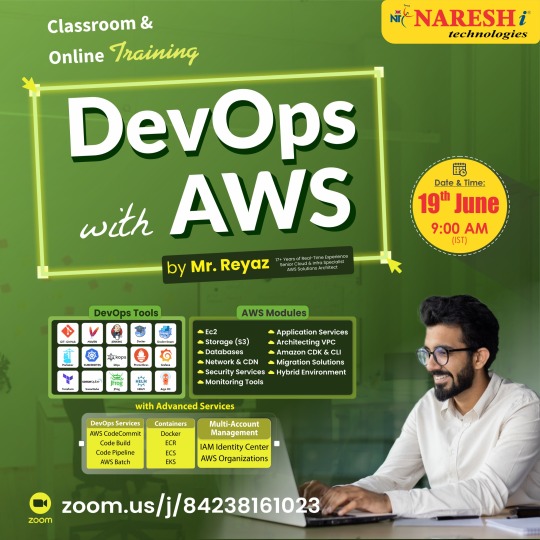
💡 Why Enroll?
Live, interactive sessions with Mr. Reyaz
Step‑by‑step labs you can pause & replay
Real‑time Q&A and doubt‑clearing support
Placement assistance to help you land that first DevOps role
🔗 Register for Early Seats – Don’t Miss Out! 👉 https://tr.ee/f3bN5E
✨ Explore even more free demo courses: 📚 https://linktr.ee/ITcoursesFreeDemos
Don’t just learn DevOps—live it. Automate your deployments, secure your cloud, and become the go‑to DevOps pro in your team.
0 notes
Text
AWS Cloud Training in Pune: The Smartest Move for Tech Enthusiasts

The world is moving to the cloud, and so should your career. As organizations adopt digital-first strategies, the need for cloud computing experts—especially those skilled in Amazon Web Services (AWS)—is rising fast. If you’re in Pune and ready to step into the world of cloud technology, AWS Cloud Training in Pune with WebAsha Technologies is your best move toward a high-growth IT career.
What is AWS? And Why Should You Learn It?
Amazon Web Services (AWS) is the most widely used cloud computing platform globally, offering secure, scalable, and cost-efficient infrastructure. It powers businesses in every domain—from tech startups to government agencies��enabling them to deploy applications, store data, and manage services in real-time.
Why AWS Skills Are Career Gold:
AWS holds over 30% of the global cloud market share
More than 1 million active users globally
High-paying job roles across industries
Certifications that are recognized worldwide
Why Choose WebAsha Technologies for AWS Cloud Training in Pune?
At WebAsha Technologies, we go beyond textbooks. We deliver career-oriented training that helps you not only learn AWS but also implement it in real-world scenarios. Whether you're a student, a working professional, or someone seeking a career change, our program is tailored to meet your goals.
What Makes Our AWS Training Stand Out?
Certified Trainers with real-time cloud project experience
Hands-On Learning with labs and practical simulations
Live Projects to prepare for real-world deployments
Updated Curriculum
Interview Preparation & Job Support
Who Can Join AWS Cloud Training in Pune?
This course is designed for learners from various backgrounds. You don’t need prior cloud experience—just curiosity and dedication.
Ideal for:
IT Professionals looking to upskill
Freshers eager to start a career in cloud computing
System Admins and Network Engineers
Software Developers and DevOps Engineers
Business Owners or Startup Founders with technical goals
Course Highlights – What You’ll Learn
Our AWS Cloud Training in Pune focuses on building your knowledge from the ground up and preparing you for AWS certifications like Solutions Architect Associate.
Core Modules Include:
Introduction to Cloud & AWS Overview
EC2: Compute Services
S3: Cloud Storage Solutions
VPC: Virtual Private Network Setup
IAM: User and Permission Management
RDS & DynamoDB: Databases on AWS
Elastic Load Balancers & Auto Scaling
Cloud Monitoring with CloudWatch
AWS Lambda & Serverless Computing
Real-World Project Deployment
Career Path After AWS Training
Once you complete the course, you can aim for industry-recognized certifications such as:
AWS Certified Cloud Practitioner
AWS Certified Solutions Architect – Associate
AWS Certified Developer – Associate
AWS Certified SysOps Administrator
Why Pune is the Perfect Place to Learn AWS
As one of India’s top IT cities, Pune hosts numerous tech parks and multinational companies. Cloud computing roles are booming here, and employers actively seek AWS-certified professionals. By completing AWS Cloud Training in Pune, you position yourself for local and global job opportunities.
Final Words: Let the Cloud Power Your Future
With cloud computing becoming essential in every sector, there has never been a better time to learn AWS. Enroll in AWS Cloud Training in Pune at WebAsha Technologies and take your first step toward a high-paying, future-ready career. Learn from experts, get hands-on experience, and earn certifications that can open doors globally.
0 notes
Text
Mastering AWS DevOps in 2025: Best Practices, Tools, and Real-World Use Cases
In 2025, the cloud ecosystem continues to grow very rapidly. Organizations of every size are embracing AWS DevOps to automate software delivery, improve security, and scale business efficiently. Mastering AWS DevOps means knowing the optimal combination of tools, best practices, and real-world use cases that deliver success in production.
This guide will assist you in discovering the most important elements of AWS DevOps, the best practices of 2025, and real-world examples of how top companies are leveraging AWS DevOps to compete.
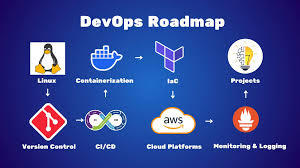
What is AWS DevOps
AWS DevOps is the union of cultural principles, practices, and tools on Amazon Web Services that enhances an organization's capacity to deliver applications and services at a higher speed. It facilitates continuous integration, continuous delivery, infrastructure as code, monitoring, and cooperation among development and operations teams.
Why AWS DevOps is Important in 2025
As organizations require quicker innovation and zero downtime, DevOps on AWS offers the flexibility and reliability to compete. Trends such as AI integration, serverless architecture, and automated compliance are changing how teams adopt DevOps in 2025.
Advantages of adopting AWS DevOps:
1 Faster deployment cycles
2 Enhanced system reliability
3 Flexible and scalable cloud infrastructure
4 Automation from code to production
5 Integrated security and compliance
Best AWS DevOps Tools to Learn in 2025
These are the most critical tools fueling current AWS DevOps pipelines:
AWS CodePipeline
Your release process can be automated with our fully managed CI/CD service.
AWS CodeBuild
Scalable build service for creating ready-to-deploy packages, testing, and building source code.
AWS CodeDeploy
Automates code deployments to EC2, Lambda, ECS, or on-prem servers with zero-downtime approaches.
AWS CloudFormation and CDK
For infrastructure as code (IaC) management, allowing repeatable and versioned cloud environments.
Amazon CloudWatch
Facilitates logging, metrics, and alerting to track application and infrastructure performance.
AWS Lambda
Serverless compute that runs code in response to triggers, well-suited for event-driven DevOps automation.
AWS DevOps Best Practices in 2025
1. Adopt Infrastructure as Code (IaC)
Utilize AWS CloudFormation or Terraform to declare infrastructure. This makes it repeatable, easier to collaborate on, and version-able.
2. Use Full CI/CD Pipelines
Implement tools such as CodePipeline, GitHub Actions, or Jenkins on AWS to automate deployment, testing, and building.
3. Shift Left on Security
Bake security in early with Amazon Inspector, CodeGuru, and Secrets Manager. As part of CI/CD, automate vulnerability scans.
4. Monitor Everything
Utilize CloudWatch, X-Ray, and CloudTrail to achieve complete observability into your system. Implement alerts to detect and respond to problems promptly.
5. Use Containers and Serverless for Scalability
Utilize Amazon ECS, EKS, or Lambda for autoscaling. These services lower infrastructure management overhead and enhance efficiency.
Real-World AWS DevOps Use Cases
Use Case 1: Scalable CI/CD for a Fintech Startup
AWS CodePipeline and CodeDeploy were used by a financial firm to automate deployments in both production and staging environments. By containerizing using ECS and taking advantage of CloudWatch monitoring, they lowered deployment mistakes by 80 percent and attained near-zero downtime.
Use Case 2: Legacy Modernization for an Enterprise
A legacy enterprise moved its on-premise applications to AWS with CloudFormation and EC2 Auto Scaling. Through the adoption of full-stack DevOps pipelines and the transformation to microservices with EKS, they enhanced time-to-market by 60 percent.
Use Case 3: Serverless DevOps for a SaaS Product
A SaaS organization utilized AWS Lambda and API Gateway for their backend functions. They implemented quick feature releases and automatically scaled during high usage without having to provision infrastructure using CodeBuild and CloudWatch.
Top Trends in AWS DevOps in 2025
AI-driven DevOps: Integration with CodeWhisperer, CodeGuru, and machine learning algorithms for intelligence-driven automation
Compliance-as-Code: Governance policies automated using services such as AWS Config and Service Control Policies
Multi-account strategies: Employing AWS Organizations for scalable, secure account management
Zero Trust Architecture: Implementing strict identity-based access with IAM, SSO, and MFA
Hybrid Cloud DevOps: Connecting on-premises systems to AWS for effortless deployments
Conclusion
In 2025, becoming a master of AWS DevOps means syncing your development workflows with cloud-native architecture, innovative tools, and current best practices. With AWS, teams are able to create secure, scalable, and automated systems that release value at an unprecedented rate.
Begin with automating your pipelines, securing your deployments, and scaling with confidence. DevOps is the way of the future, and AWS is leading the way.
Frequently Asked Questions
What distinguishes AWS DevOps from DevOps? While AWS DevOps uses AWS services and tools to execute DevOps, DevOps itself is a practice.
Can small teams benefit from AWS DevOps
Yes. AWS provides fully managed services that enable small teams to scale and automate without having to handle complicated infrastructure.
Which programming languages does AWS DevOps support
AWS supports the big ones - Python, Node.js, Java, Go, .NET, Ruby, and many more.
Is AWS DevOps for enterprise-scale applications
Yes. Large enterprises run large-scale, multi-region applications with millions of users using AWS DevOps.
1 note
·
View note